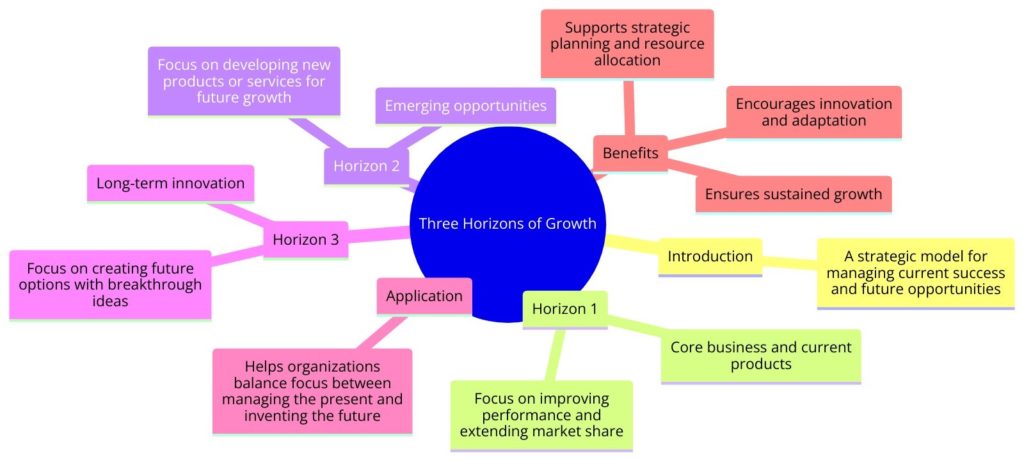Three Horizons of Growth Framework
The Three Horizons of Growth framework is a strategic model that helps organizations manage their current success while simultaneously exploring future opportunities. Developed by Mehrdad Baghai, Stephen Coley, and David White for McKinsey & Company in the late 1990s, this model is detailed in their book, “The Alchemy of Growth.” The framework offers a structured approach for companies to think about their business’s growth and innovation strategies across three different “horizons.”
What is the Three Horizons of Growth Framework?
The Three Horizons of Growth framework divides a company’s growth initiatives into three horizons based on their maturity and potential for revenue generation. Each horizon represents a different category of growth opportunities, requiring different levels of investment, management approaches, and expected returns:
- Horizon 1: Focuses on the core businesses that currently generate the most significant profits and cash flow. The goal here is to defend and extend these businesses, optimizing and enhancing current operations, products, and markets.
- Horizon 2: Involves emerging opportunities that have the potential to scale and become significant profit generators in the future. These ventures are in the development stage and require substantial investment to grow.
- Horizon 3: Centers on creating future options with ventures that could significantly impact the company but are currently experimental and may not pay off for some time. These are long-term opportunities that are being incubated, often involving radical innovations or new business models.
How It Works
The Three Horizons framework guides companies in allocating resources and managing projects across different stages of growth. It suggests that organizations should not focus solely on current operations or future opportunities but should manage a portfolio that spans all three horizons simultaneously. This approach ensures that the company can sustain growth in the short term while also investing in future innovations that will drive long-term success.
- Horizon 1 strategies involve increasing efficiency, gaining market share, and extending the life of current products and services.
- Horizon 2 strategies require identifying emerging growth areas, making targeted investments, and rapidly scaling successful initiatives.
- Horizon 3 strategies involve exploring new technologies, markets, and business models, often through partnerships, acquisitions, or internal R&D projects.
Why It Is Valuable
The Three Horizons of Growth framework is valuable for several reasons:
- Balanced Portfolio: It encourages companies to maintain a balanced portfolio of growth initiatives that cater to short-term performance, medium-term growth potential, and long-term visionary projects.
- Future Readiness: By systematically investing in Horizon 3 opportunities, companies can prepare for future shifts in their industry and be at the forefront of innovation.
- Resource Allocation: Helps in strategically allocating resources and attention, ensuring that not all efforts are concentrated on the current cash cows at the expense of future growth.
- Strategic Flexibility: Provides a structure for adapting strategy as market conditions and organizational capabilities evolve.
When and How to Use It
The Three Horizons framework can be used during strategic planning sessions, innovation management processes, and when reviewing investment portfolios. It is particularly useful for:
- Organizations looking to balance short-term performance pressures with long-term growth.
- Companies in rapidly changing industries need to innovate continuously to stay relevant.
- Businesses seeking to diversify their growth strategy and explore new markets or technologies.
Implementing the framework involves:
- Assess current growth initiatives and categorize them into three horizons.
- Ensuring a balanced allocation of resources across all three horizons.
- Setting specific goals and metrics for initiatives in each horizon.
- Regularly reviewing and adjusting the portfolio as initiatives progress or as market conditions change.
Shortcomings/Criticisms
Despite its usefulness, the Three Horizons of Growth framework has faced criticism:
- Over-Simplification: Some argue that the framework oversimplifies complex strategic decisions and doesn’t account for the nuances of each opportunity.
- Execution Challenge: Effectively balancing and managing initiatives across all three horizons can be challenging, especially in organizations with limited resources.
- Dynamic Markets: In fast-moving industries, the distinction between the horizons can blur, making it difficult to categorize initiatives neatly.
The Three Horizons of Growth framework provides a valuable lens through which companies can evaluate and manage their growth strategies. It helps organizations maintain a balance between optimizing current operations and investing in future opportunities. However, its successful implementation requires careful consideration of the company’s strategic objectives, market conditions, and internal capabilities.


